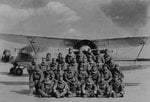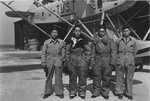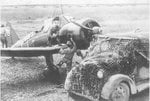Light bombers carried a relatively light bomb load but were suitable for tactical missions requiring rapid response and flexibility. Most were single engine aircraft with a crew of two or three. Dive bombers specialized in accurate attacks with bombs against high-valued land or naval targets. Torpedo bombers, as the name implies, were naval aircraft specializing in delivering torpedoes against shipping, but they could also be employed as horizontal bombers against ground targets. A few light bombers, particularly in Japanese service, were capable neither of carrying torpedoes nor of maintaining the steep dives characteristic of dive bombers. These are listed below. In addition to the other qualities desirable in a light bomber, a carrier bomber had to have a low enough landing speed to operate off a short flight deck, enough resistance to corrosion to endure salt air, and a sturdy undercarriage for hard landings on flight decks. These requirements did not constrain carrier bomber design as severely as they did carrier fighter design. In fact, it was rare for land-based light bombers to be as successful as carrier bombers. As Bergerud points out, ships are valuable targets, and a combat attrition rate that is acceptable when attacking shipping may not be acceptable for ground support missions.
Reconnaissance aircraft are aircraft designed to gather intelligence, usually by visual observation, aerial photography, or radar. While almost any aircraft had significant reconnaissance capability, the ideal reconnaissance aircraft was capable of flying high and fast to avoid interception by fighters and had a long range. Combat capability was much less important. Strategic reconnaissance missions were flown by long-range aircraft with high-resolution photographic equipment. Of these, the best was probably the Japanese Ki-46 Dinah, whose combination of speed, service ceiling, and range made it nearly the ideal reconnaissance aircraft. Allied fighter pilots found it extremely difficult to intercept, and Dinahs participated in the photoreconnaissance of Malaya and the Philippines before the war and on missions over Ulithi and Okinawa in its final months. The closest Allied equivalent was the reconnaissance version of the British Mosquito, which because it was made largely of plywood had a low radar cross-section, making it arguably the first stealth aircraft.
Reconnaissance aircraft are aircraft designed to gather intelligence, usually by visual observation, aerial photography, or radar. While almost any aircraft had significant reconnaissance capability, the ideal reconnaissance aircraft was capable of flying high and fast to avoid interception by fighters and had a long range. Combat capability was much less important. Strategic reconnaissance missions were flown by long-range aircraft with high-resolution photographic equipment. Of these, the best was probably the Japanese Ki-46 Dinah, whose combination of speed, service ceiling, and range made it nearly the ideal reconnaissance aircraft. Allied fighter pilots found it extremely difficult to intercept, and Dinahs participated in the photoreconnaissance of Malaya and the Philippines before the war and on missions over Ulithi and Okinawa in its final months. The closest Allied equivalent was the reconnaissance version of the British Mosquito, which because it was made largely of plywood had a low radar cross-section, making it arguably the first stealth aircraft.











































